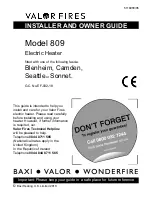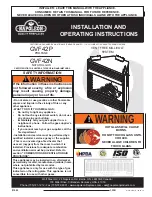
27
Servicing should only be performed by a Qualified Service Technician
CLEANING METHOD:
If corrosion is present on the air side of the anode, use a wire brush to clean the outer nut and brass wire
terminal tab. To clean the inner nut, remove the outer nut and the brass wire terminal tab. DO NOT REMOVE
inner nut. Clean with wire brush. Reassemble and connect blue wire to brass terminal tab.
FRONT ANODE REPLACEMENT METHOD:
1.
Remove blue wire from anode brass terminal.
2.
Using a (1-1/16”) socket remove the anode.
3.
Use a round wire brush to clean the spud threads. If reusing the same anode, clean the bottom disc on
the anode flange.
4.
Apply Teflon tape pipe sealant to the new anode threads (as shown below), then insert anode and tighten
securely.
5.
Reconnect blue wire to anode brass terminal.
6. If necessary, bend brass terminal tab up to allow for socket tool to fit properly.
REAR ANODE REPLACEMENT METHOD:
1.
Remove the two blower connectors from the blower; remove gas valve power plug and the two wires from
the low gas pressure switch.
2.
Remove air intake rubber boot from blower.
3.
Disconnect gas supply connection from gas valve.
4.
Remove the four (4) blower mounting screws to remove blower. Using a T-handle or hex head wrench
usually provides adequate access.
5.
Remove blower assembly with gas valve attached.
6. Repeat steps 1-6 from the Front Anode Replacement Method.
RE-ASSEMBLY:
1.
Replace blower gas valve assembly; re-install the four (4) blower mounting screws.
2.
Re-connect gas supply to the gas valve.
3.
Re-install the air intake rubber boot to the blower.
4.
Connect the two blower connector wires; connect the gas valve power supply plug and the two low gas
pressure switch wires.
5.
Turn on the water supply; be sure tank is filled with water.
6. Check the power anode voltage to measure the tank potential.
7.
Turn on the gas and power supply.
8. Restart the heater.
















































